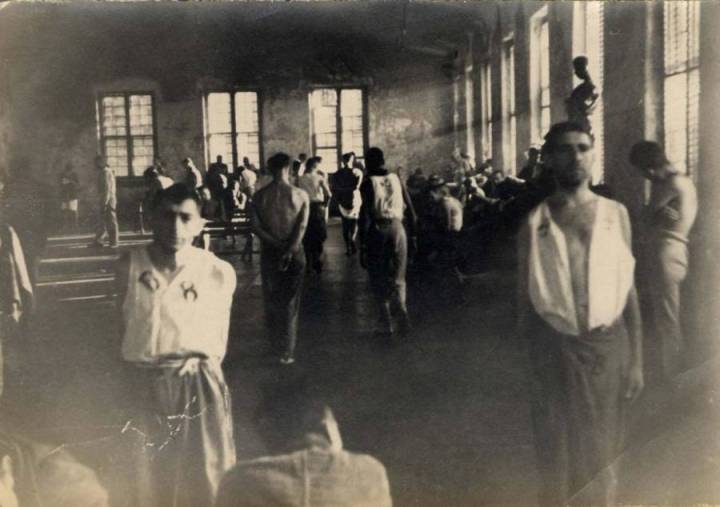“Thousands spend their days – often for weeks at a stretch – locked in devices euphemistically called ‘restraints’: thick leather handcuffs, great canvas camisoles, ‘muffs,’ ‘mitts,’ wristlets, locks and straps and restraining sheets. Hundreds are confined in ‘lodges’ – bare, bed-less rooms reeking with filth and feces – by day lit only through half-inch holes in steel-plated windows, by night merely black tombs in which the cries of the insane echo unheard from the peeling plaster of the walls.”

While the description above sounds like something out of a horror movie, it actually comes from a 1946 LIFE Magazine exposé of Philadelphia’s Byberry mental hospital.
Even today, inhumane conditions and patient abuse are the main legacies of the Byberry mental hospital (officially known as the Philadelphia State Hospital).
What started out as a working farm for a few unstable patients at a time in 1903 eventually grew into a multi-building campus. Although it relieved overcrowding from the other mental facilities in the area, it grew so fast that it couldn’t entice enough staff to work there.
Soon, facility administrators were letting people work there even if they weren’t especially qualified — if you needed a job, you had one. Perhaps some that were employed there even fit the bill for admission.
At the same time, close to 3,000 conscientious objectors who didn’t fight in World War II for religious reasons were sent to work at mental hospitals around the country. It was largely via these pacifists’ accounts and photographs that the abusive conditions inside Byberry mental hospital were finally brought to light.
Although some dedicated, caring, and hard-working staff at the Byberry mental hospital truly cared for the patients, a number of bad employees carried out abuses that remain disturbing

Due to the understaffing, there was an extremely low ratio of orderlies to patients at the Byberry mental hospital. Because of this, residents were often left unbathed and naked. Housekeeping fell behind, bedding was unwashed, and floors were sticky with urine. Instead of tending to the patients, staff put them in four-point restraints — sometimes for months at a time.
As recently as the late 1980s, 27-year-old resident William Kirsch was in such restraints for more than 14 months — and possibly as long as three years.
The U.S. District Court for Eastern Pennsylvania found that Byberry was infringing on Kirsch’s human rights, and demanded his release from the hospital. “I hope that the state has not injured this poor young man to the point where it is now irreparable,” said his attorney, Stephen Gold. “He was much better when he went in there seven or eight years ago.”
By 1970, more than a decade before Kirch’s case even, there were at least 57 deaths attributed solely to patient neglect at Byberry mental hospital — and probably many more that went unreported.

Byberry’s open-door policy for high-functioning residents made it easy for certain people to escape. Homeowners in the area sometimes found patients sleeping on their lawns. However, some patients who wandered off ended up committing suicide not far from the hospital.
One patient escaped on a cold February day. But when he reconsidered his decision, he couldn’t find any staff to let him back inside. He died of exposure.
A 1946 newspaper article from the Philadelphia Record describes Byberry’s “water cure”:
“[An attendant] soaked a large towel in water. After wringing it out, he clamped the towel around the patient’s neck. The attendant pulled the ends together, and began to twist. First he tightened the noose. Then he gave the towel a slow turn to let the patient know what was in store for him. The patient begged for mercy. But the twisting continued. The patient’s eyes bulged, his tongue swelled, his breathing labored. At length, his body fell back on the bed. His face was a dreadful white, and he did not appear to be breathing. Fifteen minutes elapsed before he showed signs of returning to life. The patient was ‘subdued’.”
This left no physical marks on the patient, so like a lot of other awful shit, it went unrecognized.
Some of the most excruciating abuses at the Byberry mental hospital came during the course of “treatment.” Doctors pulled teeth without administering novocaine, for example, and performed other medical procedures without painkillers.
Unable to fully understand and consent and in some cases without family members to notify if a fatality occurred, patients were coerced into “volunteering” for these drug trials. Ultimately, hundreds of patients at the Byberry mental hospital died during these trials.
In 1919, two orderlies at the Byberry mental hospital confessed to strangling a patient until his eyes popped out. The orderlies blamed their actions on having PTSD from World War I. Not only were they not prosecuted, they were kept on staff — at a higher pay grade.
In addition to cases of staff killing patients, cases of patients killing other patients also piled up. On top of the mentally unstable, Byberry also housed many criminals sent there to undergo “psychiatric testing” in lieu of prison.
One patient even attempted murder with a sharpened spoon in 1944.
One female patient was raped, killed, and discarded on the property by a fellow patient in 1987. The staff finally discovered her body after other residents were found carrying around her teeth.
Two more dead patients were recovered from the property in 1989, when groundskeepers cleared the weeds that had accumulated around the building. One of these patients had been missing for close to five months. It seems as though there were a few residents who simply just “went missing” and nobody had time to look for them. So yeah this place was terrible, the staff obviously didn’t give a shit about the patients.
Finally, on June 21, 1990, after decades of controversy, the Byberry mental hospital closed its doors.

